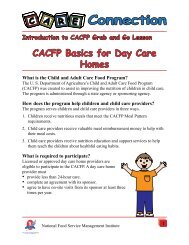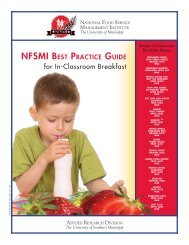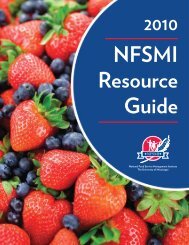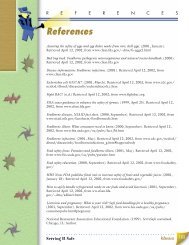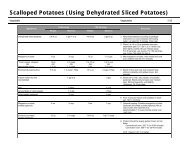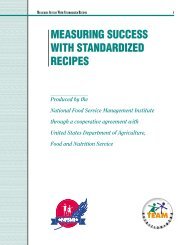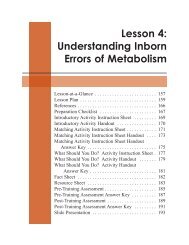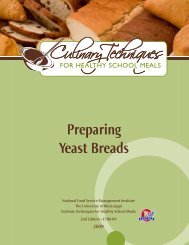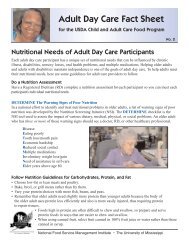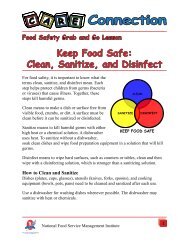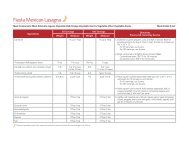financial management information system - National Food Service ...
financial management information system - National Food Service ...
financial management information system - National Food Service ...
You also want an ePaper? Increase the reach of your titles
YUMPU automatically turns print PDFs into web optimized ePapers that Google loves.
F INANCIAL A NALYSIS AND P ROGRAM E VALUATION S ECTION 4Non-reimbursable <strong>Food</strong> ItemsSchool foodservice operations must establish appropriate selling prices for non-reimbursable food items that are soldseparately from the school meal. There are several factors that influence prices charged for extra food or a la carte items soldto both students and adults. The factors most likely to influence prices charged for non-reimbursable food items include:• demand• perception of value• prices charged in nearby school districts• relationship between sales prices and volume• total costs to prepare item• promotional activities (i.e., pricing foods with high nutritional value, such as fruit, to encourage higher sales)There are several methods used in the foodservice industry to price food items that are sold individually. Each method helpsensure that in addition to costs, the customer’s perception of value for price and the organization’s <strong>financial</strong> goals areconsidered in setting the selling price. While school foodservice administrators must decide on a method that best fits theirdistrict, the two methods discussed below are easy to use and may be a good starting point from which other factors areconsidered and the price adjusted accordingly.Method # 1: Desired <strong>Food</strong> Cost Percent Mark-upThe desired food cost percent mark-up is one of the simplest methods used to determine the price of a food item. Althougheasier and less complicated to use than other methods, it has some disadvantages in that it only establishes a base sellingprice and may not necessarily reflect all other considerations. It should be emphasized that because the mark-up is based onlyon food cost, other factors should be considered before establishing a final selling price.There are three steps to establishing the base selling price for a food item using a desired food cost percent mark-up method.1. Determine the standard food cost of the item offered for sale.2. Identify the desired food-cost percentage for the operation.3. Establish a base selling price by dividing the item’s standard food cost by the desired food cost percent.Base Selling Price = Item’s Standard <strong>Food</strong> CostDesired <strong>Food</strong> Cost Percent (divided by 100)Example: A school foodservice operation set a goal of 38% as a desirable food cost percentage for the school year.Students are allowed to purchase extra slices of pizza with meals. The raw food cost for one slice (serving) of pizza is $.52.The base selling price for a slice of pizza using the desired food cost percent mark-up can be calculated as follows:Base Selling Price = $.52 = $1.368438 ÷ 100 or .38If <strong>management</strong> prices the slice of pizza at $1.40 (rounded), this provides $.52 to cover the food cost of the pizza and $.88to cover labor and other costs associated with selling students extra slices of pizza. However, if the customer perceives avalue of $1.50 per pizza slice as reasonable, then the school foodservice <strong>management</strong> team may decide to charge the extra$.10 per slice.73N ATIONAL F OOD S ERVICE M ANAGEMENT I NSTITUTE



